Bermudan vs Korean Community Comparison
COMPARE
Bermudan
Korean
Social Comparison
Social Comparison
Bermudans
Koreans
2,838
SOCIAL INDEX
25.9/ 100
SOCIAL RATING
241st/ 347
SOCIAL RANK
6,713
SOCIAL INDEX
64.6/ 100
SOCIAL RATING
147th/ 347
SOCIAL RANK
Korean Integration in Bermudan Communities
The statistical analysis conducted on geographies consisting of 55,305,020 people shows a weak positive correlation between the proportion of Koreans within Bermudan communities in the United States with a correlation coefficient (R) of 0.212. On average, for every 1% (one percent) increase in Bermudans within a typical geography, there is an increase of 0.571% in Koreans. To illustrate, in a geography comprising of 100,000 individuals, a rise of 1,000 Bermudans corresponds to an increase of 571.0 Koreans.
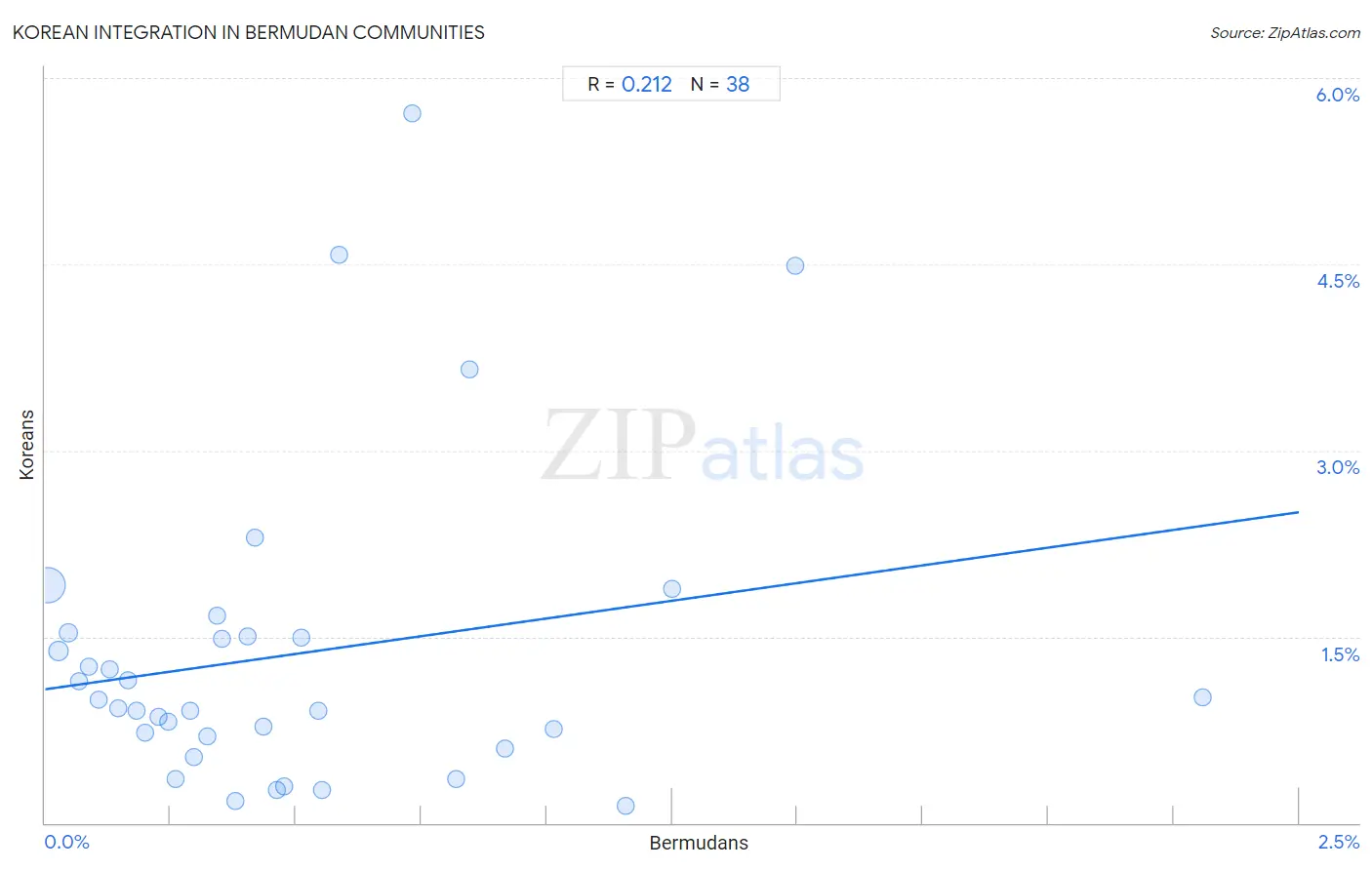
Bermudan vs Korean Income
When considering income, the most significant differences between Bermudan and Korean communities in the United States are seen in householder income under 25 years ($47,359 compared to $57,730, a difference of 21.9%), median household income ($80,406 compared to $95,018, a difference of 18.2%), and householder income ages 25 - 44 years ($88,231 compared to $103,824, a difference of 17.7%). Conversely, both communities are more comparable in terms of per capita income ($42,911 compared to $44,522, a difference of 3.7%), median female earnings ($39,418 compared to $41,276, a difference of 4.7%), and median earnings ($45,593 compared to $48,727, a difference of 6.9%).

| Income Metric | Bermudan | Korean |
| Per Capita Income | Fair $42,911 | Good $44,522 |
| Median Family Income | Tragic $97,577 | Exceptional $110,103 |
| Median Household Income | Tragic $80,406 | Exceptional $95,018 |
| Median Earnings | Fair $45,593 | Exceptional $48,727 |
| Median Male Earnings | Poor $52,465 | Excellent $56,672 |
| Median Female Earnings | Fair $39,418 | Exceptional $41,276 |
| Householder Age | Under 25 years | Tragic $47,359 | Exceptional $57,730 |
| Householder Age | 25 - 44 years | Tragic $88,231 | Exceptional $103,824 |
| Householder Age | 45 - 64 years | Tragic $94,197 | Exceptional $110,334 |
| Householder Age | Over 65 years | Tragic $58,171 | Exceptional $67,472 |
| Wage/Income Gap | Exceptional 23.1% | Good 25.4% |
Bermudan vs Korean Poverty
When considering poverty, the most significant differences between Bermudan and Korean communities in the United States are seen in child poverty under the age of 5 (19.2% compared to 14.4%, a difference of 33.4%), child poverty among boys under 16 (18.1% compared to 14.0%, a difference of 29.9%), and female poverty among 18-24 year olds (21.9% compared to 16.9%, a difference of 29.6%). Conversely, both communities are more comparable in terms of seniors poverty over the age of 75 (12.9% compared to 11.5%, a difference of 12.5%), married-couple family poverty (5.2% compared to 4.6%, a difference of 13.1%), and female poverty among 25-34 year olds (13.6% compared to 12.0%, a difference of 13.4%).
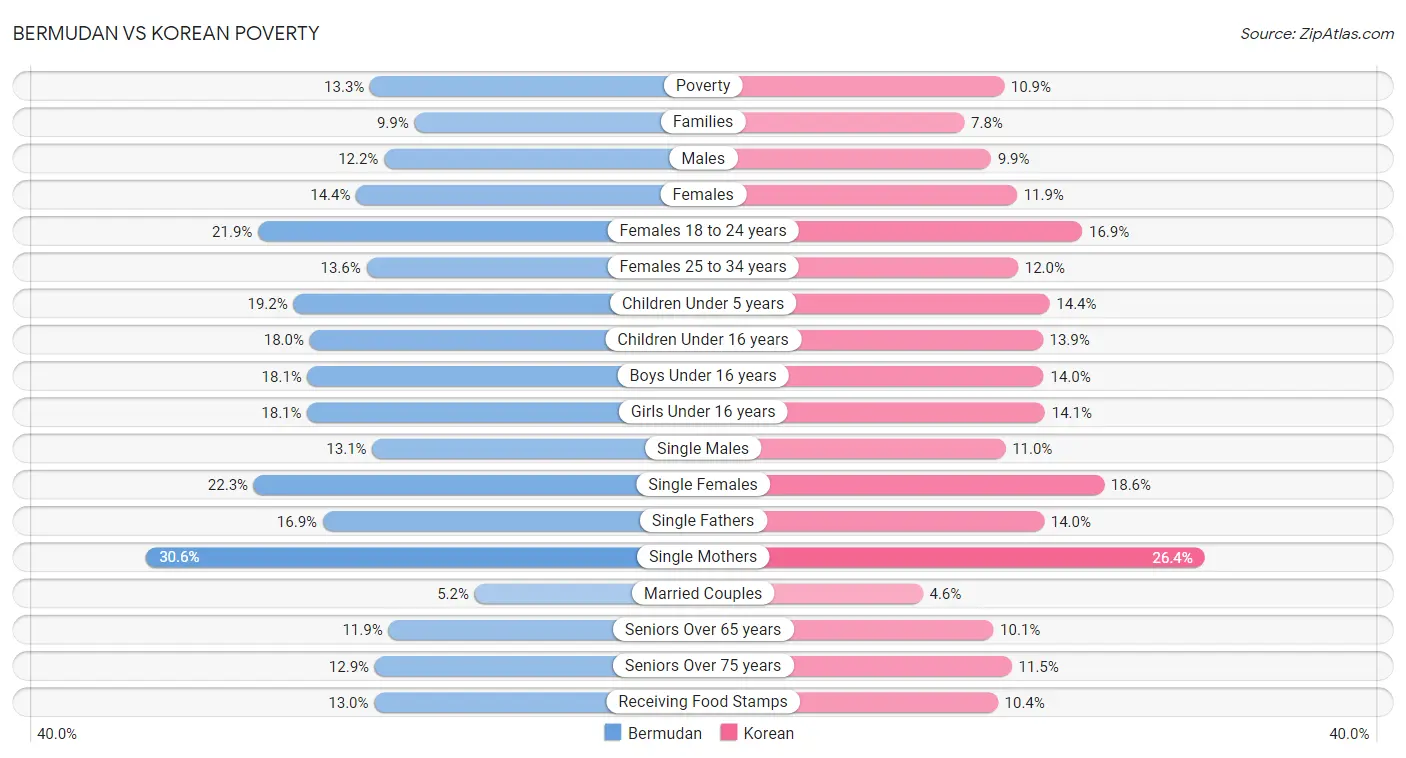
| Poverty Metric | Bermudan | Korean |
| Poverty | Tragic 13.3% | Exceptional 10.9% |
| Families | Tragic 9.9% | Exceptional 7.8% |
| Males | Tragic 12.2% | Exceptional 9.9% |
| Females | Tragic 14.4% | Exceptional 11.9% |
| Females 18 to 24 years | Tragic 21.9% | Exceptional 16.9% |
| Females 25 to 34 years | Average 13.6% | Exceptional 12.0% |
| Children Under 5 years | Tragic 19.2% | Exceptional 14.4% |
| Children Under 16 years | Tragic 18.0% | Exceptional 13.9% |
| Boys Under 16 years | Tragic 18.1% | Exceptional 14.0% |
| Girls Under 16 years | Tragic 18.1% | Exceptional 14.1% |
| Single Males | Poor 13.1% | Exceptional 11.0% |
| Single Females | Tragic 22.3% | Exceptional 18.6% |
| Single Fathers | Tragic 16.9% | Exceptional 14.0% |
| Single Mothers | Tragic 30.6% | Exceptional 26.4% |
| Married Couples | Average 5.2% | Exceptional 4.6% |
| Seniors Over 65 years | Tragic 11.9% | Exceptional 10.1% |
| Seniors Over 75 years | Tragic 12.9% | Exceptional 11.5% |
| Receiving Food Stamps | Tragic 13.0% | Exceptional 10.4% |
Bermudan vs Korean Unemployment
When considering unemployment, the most significant differences between Bermudan and Korean communities in the United States are seen in unemployment among women with children ages 6 to 17 years (10.5% compared to 8.2%, a difference of 28.2%), unemployment among ages 20 to 24 years (12.5% compared to 10.3%, a difference of 20.9%), and unemployment among ages 65 to 74 years (6.3% compared to 5.3%, a difference of 18.4%). Conversely, both communities are more comparable in terms of unemployment among ages 16 to 19 years (17.6% compared to 17.5%, a difference of 0.59%), unemployment among seniors over 75 years (8.9% compared to 8.9%, a difference of 0.61%), and female unemployment (5.4% compared to 5.4%, a difference of 0.65%).
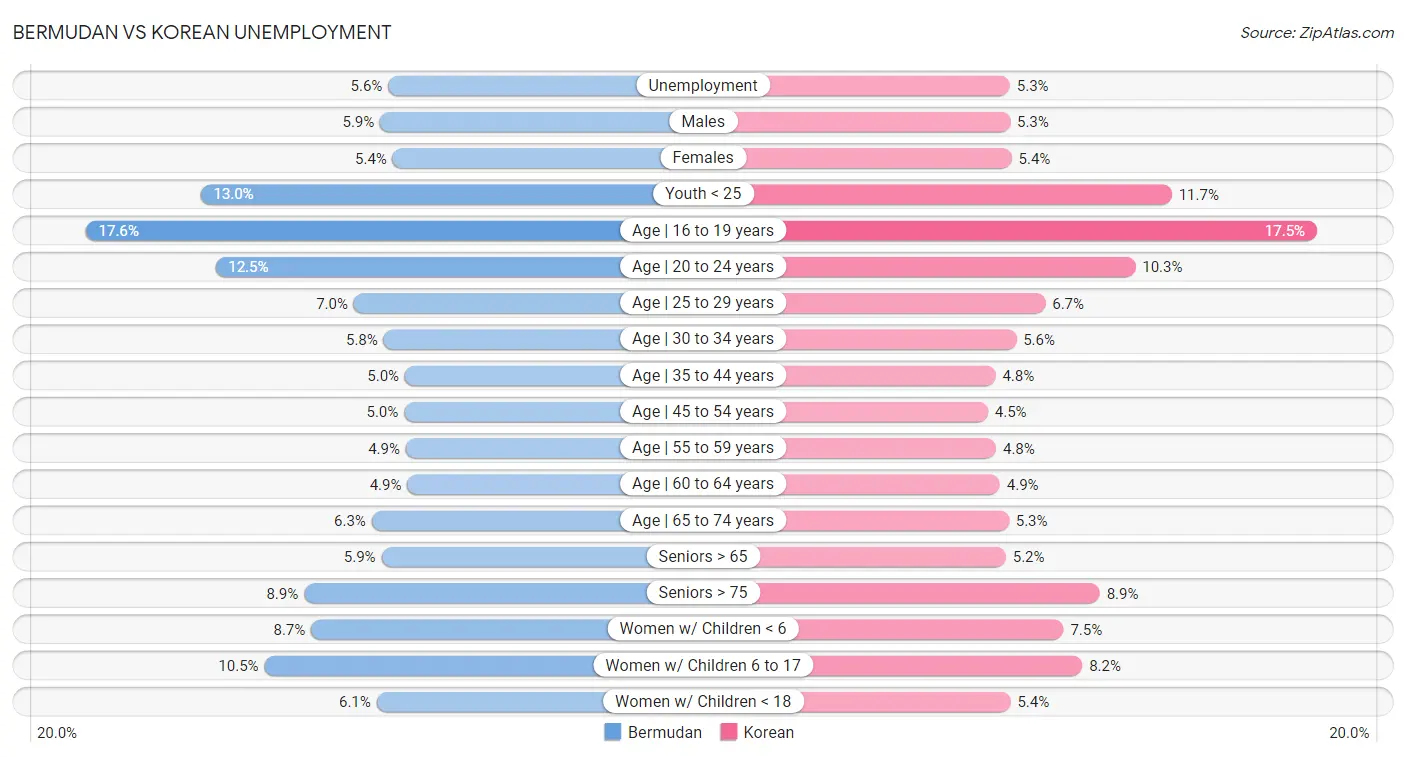
| Unemployment Metric | Bermudan | Korean |
| Unemployment | Tragic 5.6% | Fair 5.3% |
| Males | Tragic 5.9% | Fair 5.3% |
| Females | Tragic 5.4% | Poor 5.4% |
| Youth < 25 | Tragic 13.0% | Fair 11.7% |
| Age | 16 to 19 years | Average 17.6% | Good 17.5% |
| Age | 20 to 24 years | Tragic 12.5% | Average 10.3% |
| Age | 25 to 29 years | Tragic 7.0% | Fair 6.7% |
| Age | 30 to 34 years | Tragic 5.8% | Fair 5.6% |
| Age | 35 to 44 years | Tragic 5.0% | Fair 4.8% |
| Age | 45 to 54 years | Tragic 5.0% | Good 4.5% |
| Age | 55 to 59 years | Poor 4.9% | Good 4.8% |
| Age | 60 to 64 years | Average 4.9% | Poor 4.9% |
| Age | 65 to 74 years | Tragic 6.3% | Excellent 5.3% |
| Seniors > 65 | Tragic 5.9% | Fair 5.2% |
| Seniors > 75 | Poor 8.9% | Fair 8.9% |
| Women w/ Children < 6 | Tragic 8.7% | Excellent 7.5% |
| Women w/ Children 6 to 17 | Tragic 10.5% | Exceptional 8.2% |
| Women w/ Children < 18 | Tragic 6.1% | Good 5.4% |
Bermudan vs Korean Labor Participation
When considering labor participation, the most significant differences between Bermudan and Korean communities in the United States are seen in in labor force | age 16-19 (36.9% compared to 35.7%, a difference of 3.5%), in labor force | age 25-29 (86.0% compared to 84.2%, a difference of 2.2%), and in labor force | age 20-24 (74.1% compared to 75.4%, a difference of 1.8%). Conversely, both communities are more comparable in terms of in labor force | age 45-54 (83.1% compared to 82.9%, a difference of 0.23%), in labor force | age 20-64 (80.0% compared to 79.8%, a difference of 0.25%), and in labor force | age > 16 (66.0% compared to 65.7%, a difference of 0.56%).

| Labor Participation Metric | Bermudan | Korean |
| In Labor Force | Age > 16 | Exceptional 66.0% | Exceptional 65.7% |
| In Labor Force | Age 20-64 | Exceptional 80.0% | Good 79.8% |
| In Labor Force | Age 16-19 | Good 36.9% | Poor 35.7% |
| In Labor Force | Age 20-24 | Tragic 74.1% | Good 75.4% |
| In Labor Force | Age 25-29 | Exceptional 86.0% | Tragic 84.2% |
| In Labor Force | Age 30-34 | Exceptional 85.9% | Fair 84.5% |
| In Labor Force | Age 35-44 | Exceptional 85.3% | Fair 84.3% |
| In Labor Force | Age 45-54 | Excellent 83.1% | Good 82.9% |
Bermudan vs Korean Family Structure
When considering family structure, the most significant differences between Bermudan and Korean communities in the United States are seen in single mother households (7.3% compared to 6.0%, a difference of 20.9%), births to unmarried women (35.5% compared to 30.1%, a difference of 18.0%), and married-couple households (42.4% compared to 49.7%, a difference of 17.2%). Conversely, both communities are more comparable in terms of average family size (3.20 compared to 3.36, a difference of 5.0%), family households (62.2% compared to 68.3%, a difference of 9.8%), and currently married (43.5% compared to 47.9%, a difference of 10.2%).

| Family Structure Metric | Bermudan | Korean |
| Family Households | Tragic 62.2% | Exceptional 68.3% |
| Family Households with Children | Tragic 26.3% | Exceptional 29.2% |
| Married-couple Households | Tragic 42.4% | Exceptional 49.7% |
| Average Family Size | Poor 3.20 | Exceptional 3.36 |
| Single Father Households | Exceptional 2.1% | Fair 2.4% |
| Single Mother Households | Tragic 7.3% | Excellent 6.0% |
| Currently Married | Tragic 43.5% | Exceptional 47.9% |
| Divorced or Separated | Tragic 12.7% | Exceptional 11.3% |
| Births to Unmarried Women | Tragic 35.5% | Excellent 30.1% |
Bermudan vs Korean Vehicle Availability
When considering vehicle availability, the most significant differences between Bermudan and Korean communities in the United States are seen in no vehicles in household (12.8% compared to 8.0%, a difference of 59.9%), 4 or more vehicles in household (5.6% compared to 8.6%, a difference of 53.9%), and 3 or more vehicles in household (17.8% compared to 24.1%, a difference of 35.5%). Conversely, both communities are more comparable in terms of 1 or more vehicles in household (87.5% compared to 92.1%, a difference of 5.2%), 2 or more vehicles in household (50.6% compared to 61.0%, a difference of 20.5%), and 3 or more vehicles in household (17.8% compared to 24.1%, a difference of 35.5%).

| Vehicle Availability Metric | Bermudan | Korean |
| No Vehicles Available | Tragic 12.8% | Exceptional 8.0% |
| 1+ Vehicles Available | Tragic 87.5% | Exceptional 92.1% |
| 2+ Vehicles Available | Tragic 50.6% | Exceptional 61.0% |
| 3+ Vehicles Available | Tragic 17.8% | Exceptional 24.1% |
| 4+ Vehicles Available | Tragic 5.6% | Exceptional 8.6% |
Bermudan vs Korean Education Level
When considering education level, the most significant differences between Bermudan and Korean communities in the United States are seen in no schooling completed (2.1% compared to 2.4%, a difference of 10.7%), master's degree (15.4% compared to 14.0%, a difference of 10.1%), and doctorate degree (1.8% compared to 1.7%, a difference of 7.4%). Conversely, both communities are more comparable in terms of ged/equivalency (85.8% compared to 85.6%, a difference of 0.29%), nursery school (98.0% compared to 97.7%, a difference of 0.33%), and kindergarten (98.0% compared to 97.6%, a difference of 0.33%).
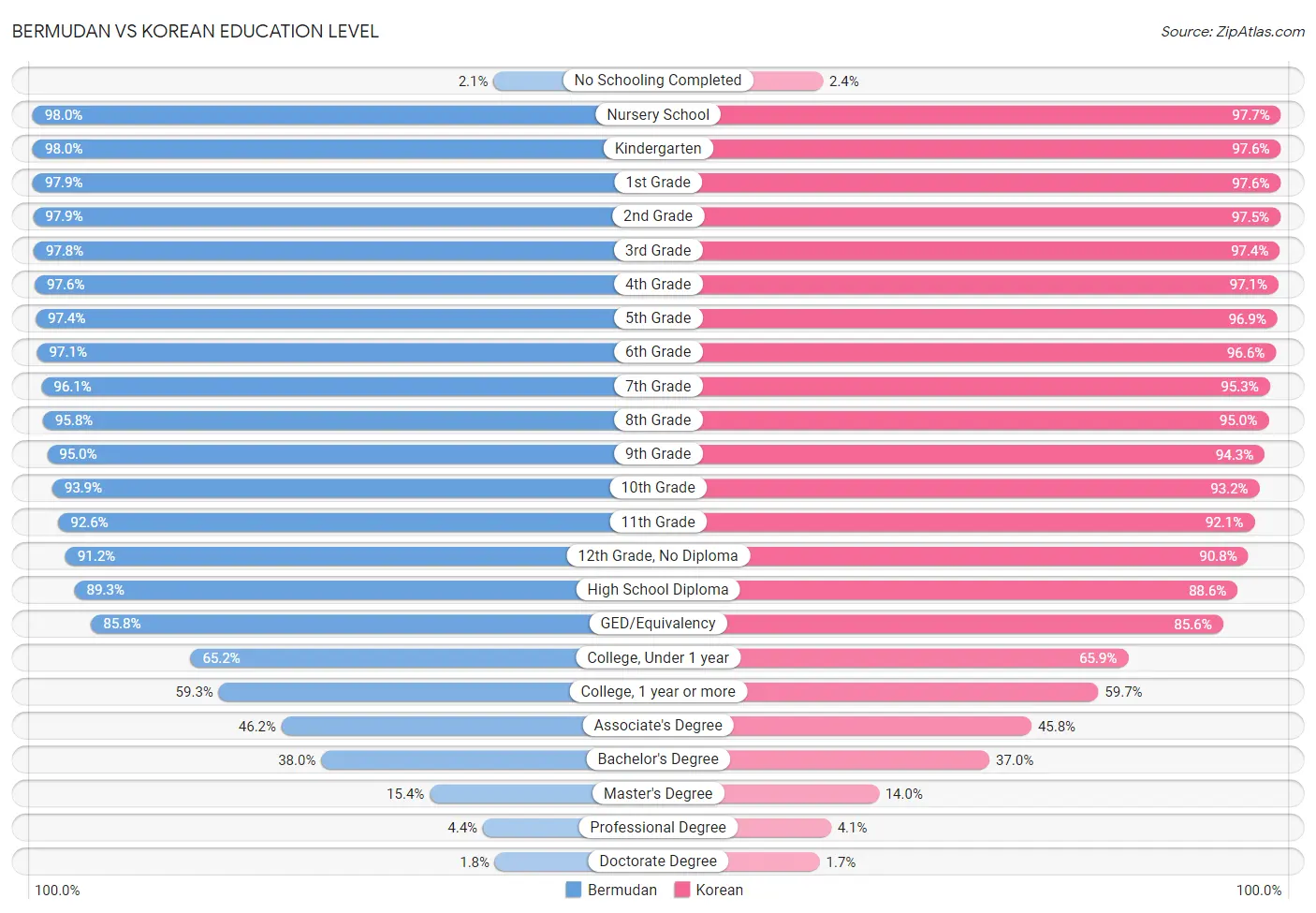
| Education Level Metric | Bermudan | Korean |
| No Schooling Completed | Fair 2.1% | Tragic 2.4% |
| Nursery School | Average 98.0% | Tragic 97.7% |
| Kindergarten | Average 98.0% | Tragic 97.6% |
| 1st Grade | Average 97.9% | Tragic 97.6% |
| 2nd Grade | Average 97.9% | Tragic 97.5% |
| 3rd Grade | Good 97.8% | Tragic 97.4% |
| 4th Grade | Good 97.6% | Tragic 97.1% |
| 5th Grade | Average 97.4% | Tragic 96.9% |
| 6th Grade | Average 97.1% | Tragic 96.6% |
| 7th Grade | Good 96.1% | Tragic 95.3% |
| 8th Grade | Good 95.8% | Tragic 95.0% |
| 9th Grade | Good 95.0% | Tragic 94.3% |
| 10th Grade | Good 93.9% | Tragic 93.2% |
| 11th Grade | Good 92.6% | Poor 92.1% |
| 12th Grade, No Diploma | Average 91.2% | Fair 90.8% |
| High School Diploma | Good 89.3% | Poor 88.6% |
| GED/Equivalency | Average 85.8% | Average 85.6% |
| College, Under 1 year | Average 65.2% | Good 65.9% |
| College, 1 year or more | Average 59.3% | Average 59.7% |
| Associate's Degree | Average 46.2% | Fair 45.8% |
| Bachelor's Degree | Average 38.0% | Fair 37.0% |
| Master's Degree | Good 15.4% | Poor 14.0% |
| Professional Degree | Average 4.4% | Poor 4.1% |
| Doctorate Degree | Average 1.8% | Poor 1.7% |
Bermudan vs Korean Disability
When considering disability, the most significant differences between Bermudan and Korean communities in the United States are seen in disability age 5 to 17 (6.4% compared to 5.1%, a difference of 25.6%), disability age 18 to 34 (7.3% compared to 6.3%, a difference of 16.9%), and disability age under 5 (1.4% compared to 1.2%, a difference of 15.6%). Conversely, both communities are more comparable in terms of self-care disability (2.6% compared to 2.5%, a difference of 2.6%), disability age over 75 (46.9% compared to 48.6%, a difference of 3.7%), and disability age 65 to 74 (24.2% compared to 23.1%, a difference of 4.4%).
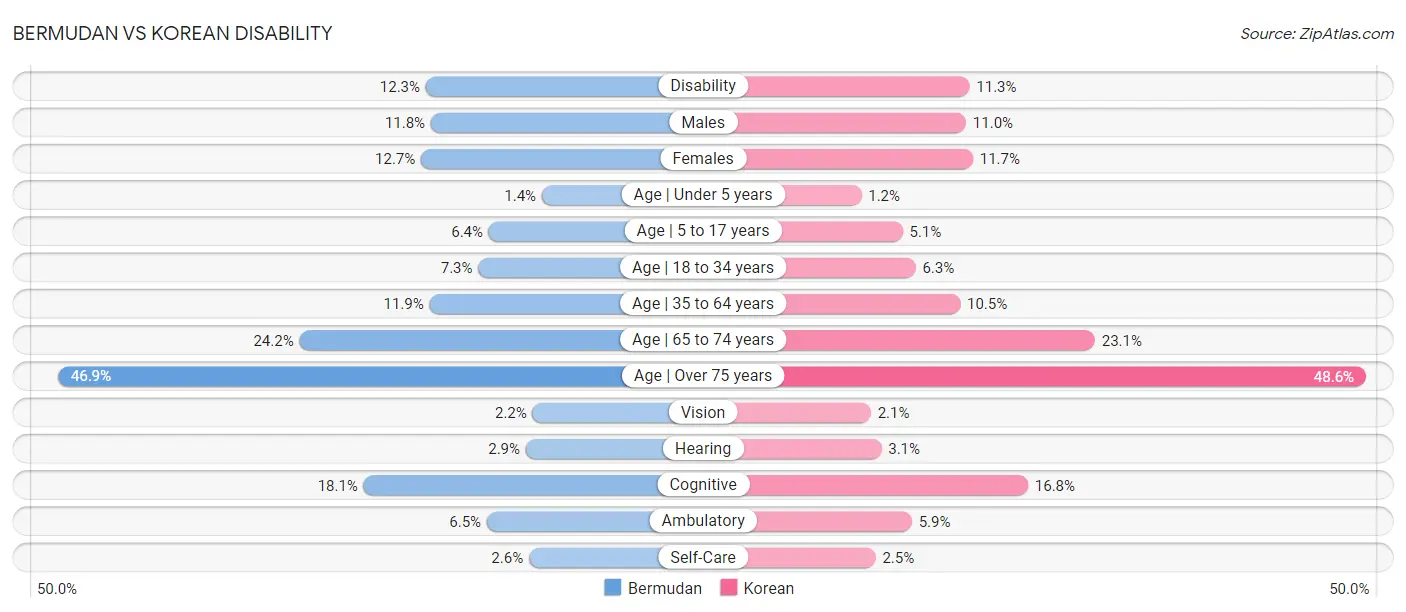
| Disability Metric | Bermudan | Korean |
| Disability | Tragic 12.3% | Exceptional 11.3% |
| Males | Tragic 11.8% | Good 11.0% |
| Females | Tragic 12.7% | Exceptional 11.7% |
| Age | Under 5 years | Tragic 1.4% | Excellent 1.2% |
| Age | 5 to 17 years | Tragic 6.4% | Exceptional 5.1% |
| Age | 18 to 34 years | Tragic 7.3% | Exceptional 6.3% |
| Age | 35 to 64 years | Tragic 11.9% | Exceptional 10.5% |
| Age | 65 to 74 years | Tragic 24.2% | Good 23.1% |
| Age | Over 75 years | Excellent 46.9% | Tragic 48.6% |
| Vision | Tragic 2.2% | Exceptional 2.1% |
| Hearing | Excellent 2.9% | Fair 3.1% |
| Cognitive | Tragic 18.1% | Exceptional 16.8% |
| Ambulatory | Tragic 6.5% | Exceptional 5.9% |
| Self-Care | Tragic 2.6% | Poor 2.5% |